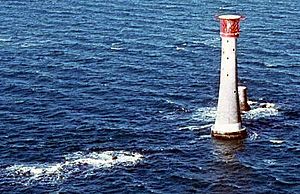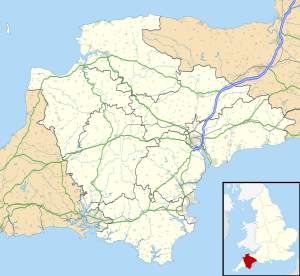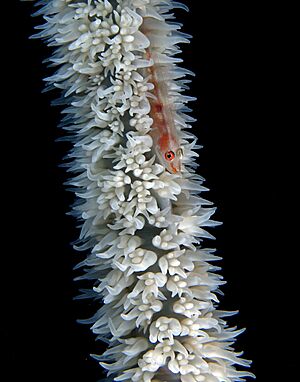Eddystone Rocks facts for kids
Quick facts for kids Eddystone Rocks |
|
|---|---|

The Eddystone Rocks, with current lighthouse and the remains of an older tower
|
|
| Location | Devon, England |
| Coordinates | 50°10.80′N 04°15.90′W / 50.18000°N 4.26500°W |
The Eddystone Rocks are a group of rocks in the sea. They are found about 9 miles (14 km) southwest of Rame Head in Cornwall, England. Even though they are close to Cornwall, these rocks are actually part of the city of Plymouth in Devon.
For hundreds of years, these rocks have been very dangerous for ships. They lie in the path to the English Channel and the port city of Plymouth. Because of this danger, four different lighthouses have been built on the Eddystone Rocks.
The first lighthouses were built by Winstanley and Rudyard. The current lighthouse, called the Douglass Lighthouse, was finished later. When it was built, the people of Plymouth were very thankful. The lighthouses had saved many lives. They paid to move the old Smeaton Lighthouse from the rocks. It was rebuilt at Plymouth Hoe, where it is now a popular tourist spot. A small part of the Smeaton lighthouse still remains on the rocks today.
The waters around the Eddystone Rocks are full of amazing sea creatures. Scientists have been studying them for over a hundred years. They want to learn how these creatures live in this special environment. The rocks themselves are made of a unique type of rock called gneiss. This kind of rock is not found anywhere else in South West England. Scientists also study how strong waves hit the rocks and the lighthouses. They also check the water quality around the rocks.
You might find the Eddystone Rocks mentioned in a few books. These include ‘The Red Rocks Of Eddystone’ by Fred Majdalany. Another is ‘South Devon's Shipwreck Trail’ by Jessica Berry. There is also a traditional sea-shanty called "The Eddystone Light".
Contents
History of the Eddystone Lighthouses

Around 1877 and 1878, there was a discussion about the Eddystone Rocks. The Corporation of Trinity House talked with the Board of Trade. They wondered if they should destroy the rocks instead of fixing the Eddystone Lighthouse. The strong tides were washing away the rocks under the lighthouse. This made people worry about the lighthouse's safety.
An engineer named T. P. Aston suggested blasting away the rock caverns. This would let ships pass through the English Channel more easily. If ships could pass through, a lighthouse might not be needed there anymore.
However, destroying the rocks would be very expensive. Engineer Jas. N. Douglass estimated that about 1.75 million tons of rock would need to be removed. This would cost at least £500,000. On the other hand, fixing and strengthening the lighthouse would cost less, around £120,000. But fixing it was hard because the tides only allowed a small window of time to work.
In the end, Trinity House decided not to spend public money to remove the rocks. The Eddystone Rocks were known as "the first rock lighthouse in the world." Even though the wind and waves wore down the rocks, constant repairs and stronger lighthouses kept the Eddystone in place.
In the 1970s, there was a question about who owned the Eddystone Rocks. This came up during talks between England and France. It was decided that the Eddystone Rocks would be used as a "base point" for drawing the sea border. This helped settle the issue of ownership for the sea area.
Amazing Sea Life at Eddystone
Since 1895, scientists have been studying the sea life around the Eddystone Reef. E. J. Allen, a director at the Plymouth Laboratory, led some of these early studies. He worked for the Marine Biological Association. They wanted to learn about the different sea creatures living there. They also studied how the seabed and water movement affected these creatures.
Allen found many different animals living in the area. This was because of the seabed, which was made of sand, fine gravel, and plant roots. The deep, untouched reef also created a good home. Some of the animals found included Antennularia antennina and Aglaophenia myriophyllum. He also noted that some animals, like Aeyonium digitatum, seemed to prefer calmer waters.
From 1992 to 2002, more studies looked at tiny organisms called ciliates. These are very small, single-celled creatures. Scientists found many types of ciliates in the water around the Eddystone Rocks. Some common ones were "Helicostomella subulata" and "Tintinnopsis beroidea." These tiny creatures are important because they can turn into food for other sea animals.
In 2000, another study focused on starfish and sea urchins. These are called echinoderms. They are the most common invertebrates (animals without backbones) in this area. Scientists found that the depth of the water and the type of seabed affected where these creatures lived. Deeper waters had more stable conditions. This meant the temperature and saltiness of the water stayed the same. Common species found included the Asterias rubens and the Psammechinus miliaris (a type of sea urchin).
In 2012, researchers Lin Baldock and Paul Kay looked for rare fish. They studied the waters between the Eddystone Reef and Plymouth. They found a special type of fish called Steven's goby (Gobius gasteveni).
The Geology of Eddystone Rocks
The rocks at Eddystone are very old. Scientists believe they formed during the end of the Devonian period. But their highly changed state suggests they might be even older. They could be from the Precambrian age, which is billions of years ago.
Studies have looked at the types of minerals in the rocks. They found minerals like quartz, muscovite, and chlorite. Scientists also studied how waves hit the rocks and the lighthouses. They used video cameras and special sensors called geophones. They found that the rocks face "dramatic wave impacts." However, the Lighthouse itself stays safe even during big winter storms.
Scientists have also studied the water around the Eddystone Rocks. They wanted to see how clean the water was. They used mussels to collect data. Mussels were left underwater for 60 days at different spots. The mussels closer to the seabed had higher levels of metals. This study showed a link between pollution in the area and metal contamination in sea life.
The Eddystone Rocks are important for drawing sea boundaries. They are considered a "basepoint" for marking the edge of the continental shelf. This means that even though the rocks cannot support people living on them, they are still important for legal reasons in the sea.
Images for kids
-
The Eddystone Rocks, with current lighthouse and the remnants of previous tower
-
Painting depicting the HMS 'Forte' sailing past the Eddystone Lighthouse (background)






